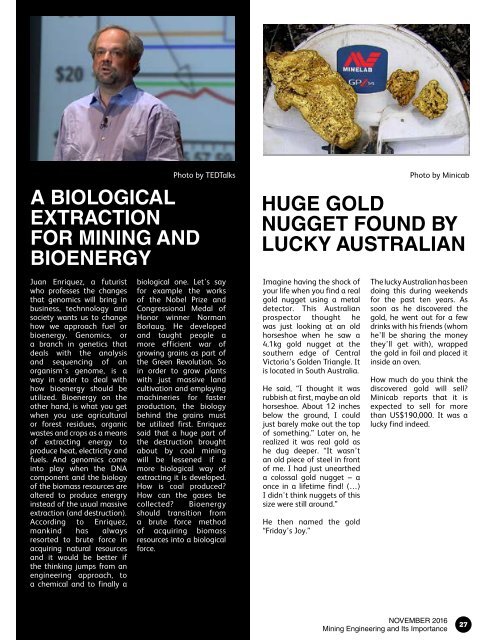GineersNow Engineering Magazine November 2016 Issue No 009
GineersNow Engineering Magazine November 2016 Issue No 009 Caterpillar Inc: A look at the company's social impact. Exclusive interview with Jean Savace, Vice President and Chief Technology Officer of Caterpillar Inc. Exclusive: Mining industry, social good, philanthropy, CSR, social impact, social innovation. Special Feature Stories: HVACR, Oil & Gas, Construction, Heavy Equipment, Machinery, Tools, Civil Engineering, Mechanical, Electrical, Plumbing, MEP, Water, Wastewater, Renewables, Energy, Petroleum, Heavy Equipment, Rental Equipment, Contractors, EPC. Country Focus: United States, Canada, United Arab Emirates, Saudi Arabia, Qatar, Bahrain, Kuwait, Oman, United Kingdom, Singapore, Hong Kong, Philippines, Malaysia, Indonesia, India, Australia More engineering stories at https://www.gineersnow.com/topics/magazines
GineersNow Engineering Magazine November 2016 Issue No 009
Caterpillar Inc: A look at the company's social impact. Exclusive interview with Jean Savace, Vice President and Chief Technology Officer of Caterpillar Inc.
Exclusive: Mining industry, social good, philanthropy, CSR, social impact, social innovation.
Special Feature Stories: HVACR, Oil & Gas, Construction, Heavy Equipment, Machinery, Tools, Civil Engineering, Mechanical, Electrical, Plumbing, MEP, Water, Wastewater, Renewables, Energy, Petroleum, Heavy Equipment, Rental Equipment, Contractors, EPC.
Country Focus: United States, Canada, United Arab Emirates, Saudi Arabia, Qatar, Bahrain, Kuwait, Oman, United Kingdom, Singapore, Hong Kong, Philippines, Malaysia, Indonesia, India, Australia
More engineering stories at https://www.gineersnow.com/topics/magazines
You also want an ePaper? Increase the reach of your titles
YUMPU automatically turns print PDFs into web optimized ePapers that Google loves.
A BIOLOGICAL<br />
EXTRACTION<br />
FOR MINING AND<br />
BIOENERGY<br />
Juan Enriquez, a futurist<br />
who professes the changes<br />
that genomics will bring in<br />
business, technnology and<br />
society wants us to change<br />
how we approach fuel or<br />
bioenergy. Genomics, or<br />
a branch in genetics that<br />
deals with the analysis<br />
and sequencing of an<br />
organism's genome, is a<br />
way in order to deal with<br />
how bioenergy should be<br />
utilized. Bioenergy on the<br />
other hand, is what you get<br />
when you use agricultural<br />
or forest residues, organic<br />
wastes and crops as a means<br />
of extracting energy to<br />
produce heat, electricity and<br />
fuels. And genomics come<br />
into play when the DNA<br />
component and the biology<br />
of the biomass resources are<br />
altered to produce energry<br />
instead of the usual massive<br />
extraction (and destruction).<br />
According to Enriquez,<br />
mankind has always<br />
resorted to brute force in<br />
acquiring natural resources<br />
and it would be better if<br />
the thinking jumps from an<br />
engineering approach, to<br />
a chemical and to finally a<br />
Photo by TEDTalks<br />
biological one. Let's say<br />
for example the works<br />
of the <strong>No</strong>bel Prize and<br />
Congressional Medal of<br />
Honor winner <strong>No</strong>rman<br />
Borlaug. He developed<br />
and taught people a<br />
more efficient war of<br />
growing grains as part of<br />
the Green Revolution. So<br />
in order to grow plants<br />
with just massive land<br />
cultivation and employing<br />
machineries for faster<br />
production, the biology<br />
behind the grains must<br />
be utilized first. Enriquez<br />
said that a huge part of<br />
the destruction brought<br />
about by coal mining<br />
will be lessened if a<br />
more biological way of<br />
extracting it is developed.<br />
How is coal produced?<br />
How can the gases be<br />
collected? Bioenergy<br />
should transition from<br />
a brute force method<br />
of acquiring biomass<br />
resources into a biological<br />
force.<br />
HUGE GOLD<br />
NUGGET FOUND BY<br />
LUCKY AUSTRALIAN<br />
Imagine having the shock of<br />
your life when you find a real<br />
gold nugget using a metal<br />
detector. This Australian<br />
prospector thought he<br />
was just looking at an old<br />
horseshoe when he saw a<br />
4.1kg gold nugget at the<br />
southern edge of Central<br />
Victoria’s Golden Triangle. It<br />
is located in South Australia.<br />
He said, “I thought it was<br />
rubbish at first, maybe an old<br />
horseshoe. About 12 inches<br />
below the ground, I could<br />
just barely make out the top<br />
of something.” Later on, he<br />
realized it was real gold as<br />
he dug deeper. “It wasn’t<br />
an old piece of steel in front<br />
of me. I had just unearthed<br />
a colossal gold nugget – a<br />
once in a lifetime find! (…)<br />
I didn't think nuggets of this<br />
size were still around.”<br />
He then named the gold<br />
“Friday’s Joy.”<br />
Photo by Minicab<br />
The lucky Australian has been<br />
doing this during weekends<br />
for the past ten years. As<br />
soon as he discovered the<br />
gold, he went out for a few<br />
drinks with his friends (whom<br />
he’ll be sharing the money<br />
they’ll get with), wrapped<br />
the gold in foil and placed it<br />
inside an oven.<br />
How much do you think the<br />
discovered gold will sell?<br />
Minicab reports that it is<br />
expected to sell for more<br />
than US$190,000. It was a<br />
lucky find indeed.<br />
NOVEMBER <strong>2016</strong><br />
Mining <strong>Engineering</strong> and Its Importance<br />
27


















